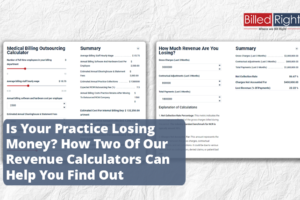Pros and Cons of In-House Medical Billing: Is It Worth the Investment?

As a Revenue Cycle Management (RCM) company, we aim to provide a clear, unbiased analysis of in-house billing versus outsourcing. We specialize in outsourced billing but recognize that in-house billing can benefit certain practices.
In this blog, we’ll cover key factors to help you decide which billing approach fits your practice—whether you’re looking to cut costs or retain control over your revenue cycle. By the end, you’ll have a clearer understanding of your best option and can use our medical billing calculator to make an informed choice.
What is In-House Billing?
Understanding In-House Medical Billing
In-house medical billing refers to the practice of managing the entire billing process within your healthcare organization, rather than outsourcing it to a third-party company.
When you choose to handle billing internally, the responsibility for all aspects of the revenue cycle management (RCM) remains within your practice.
This includes everything from submitting insurance claims and following up on denied claims to processing patient payments and maintaining compliance with constantly evolving healthcare regulations.
The core processes of in-house billing typically involve:
- Patient Registration and Data Entry: Accurate collection and input of patient information, including insurance details, demographics, and medical history, to ensure proper claim submission.
- Charge Entry and Claims Submission: Translating medical services into standardized billing codes (such as CPT and ICD-10) and submitting these claims to insurance companies for payment.
- Payment Posting and Reconciliation: Applying payments from insurers and patients to the correct accounts and ensuring accuracy in financial records.
- Denial Management and Follow-Up: Investigating and resolving denied or underpaid claims to recover owed revenue.
- Patient Billing and Collections: Generating bills for patients for services not covered by insurance and following up on unpaid balances.
- Compliance and Regulatory Updates: Staying up-to-date with industry regulations, such as HIPAA, and billing code changes to ensure that the practice remains compliant and avoids costly penalties.
Each of these steps requires careful attention to detail and a dedicated team of employees who are well-versed in both billing practices and the specific needs of your specialty.
Practices that opt for in-house billing need to hire and train billing specialists or medical coders who will manage the entire process. The practice is also responsible for the ongoing education and software updates necessary to keep up with regulatory changes and advances in technology.
In-House Billing vs. Outsourcing
While in-house billing gives you more direct control over the billing process, it also comes with significant responsibilities, such as hiring the right personnel, managing their performance, and ensuring continuous compliance. On the other hand, outsourcing billing shifts much of that responsibility to a third-party provider, like us at Billed Right, who specialize in managing the complexities of the revenue cycle on behalf of healthcare practices.
Outsourcing allows you to focus more on patient care and growth without the burden of handling billing internally. This option can help reduce overhead costs, eliminate staffing challenges, and ensure compliance with ever-changing regulations, making it an appealing alternative for many practices. However, the decision to outsource or keep billing in-house depends on factors such as the size of your practice, available resources, and your long-term goals.
Pros of In-House Billing
Benefits of In-House Medical Billing
For many healthcare practices, in-house billing offers several advantages that align with their operational goals and unique needs. Below are some of the key benefits that in-house billing can provide:
Control over the Billing Process
With in-house billing, your practice has direct oversight of the entire revenue cycle. This level of control allows for immediate adjustments to billing strategies, ensuring that processes are tailored to your practice’s specific needs. This can help you address issues quickly and implement solutions that maximize revenue.
Immediate Communication
Having an internal billing team allows for faster communication between billing staff and clinical teams. This direct access speeds up the resolution of billing issues, such as claim denials, ensuring that problems are addressed promptly, which can reduce delays in reimbursement and keep cash flow steady.
Tailored Solutions
In-house billing gives your practice the flexibility to design workflows that fit your unique operational needs. Whether it’s specialized coding for complex treatments or efficient billing for recurring services, your billing processes can be customized to improve accuracy and efficiency. This also allows you to create financial reports that align with your specific goals and help guide decision-making.
Cons of In-House Billing
Drawbacks of In-House Medical Billing
While in-house billing offers benefits, it also comes with challenges that can affect your practice’s efficiency and bottom line.
Increased Overhead Costs
Managing billing internally can significantly raise operational costs. You’ll need to hire, train, and compensate billing staff, which includes salaries, benefits, and continuous education. Additionally, investing in billing software and infrastructure can add to these expenses, making in-house billing a costly option for some practices.
Potential Gaps in Expertise
The healthcare industry is constantly evolving, with frequent changes in billing regulations, coding updates, and new technologies. Keeping your team up to date requires ongoing education and investment. Without proper training, your staff may struggle to stay compliant, leading to errors and delays in claims processing, which can affect revenue.
Risk of Burnout and Turnover
In-house billing can be stressful, especially in high-volume or complex practices. The pressure to handle claims efficiently while managing denials and staying current with regulations can lead to staff burnout. High turnover rates can disrupt the billing process, impacting your practice’s cash flow and requiring additional time and resources for hiring and training.
In-House Billing vs. Outsourcing: Who Should Choose Which?
Who Should Opt for In-House Billing vs. Outsourcing?
Deciding between in-house billing and outsourcing depends on your practice’s size, goals, and specific needs. Here’s a guide to help you determine which option might be best for you:
In-House Billing is Ideal for:
- Large Practices:
Practices or hospital systems with sufficient resources to hire, train, and retain specialized billing staff may benefit from the control and customization of in-house billing. This setup allows for a more tailored approach and direct management of the billing process. - Practices Valuing Control:
If maintaining close oversight and integration of billing processes within your operations is crucial, in-house billing provides the direct control needed to adapt workflows and address issues promptly. - Organizations with Stable Teams:
Practices that already have an experienced and reliable billing team can benefit from in-house billing, as it minimizes the risks associated with turnover and ensures continuity in billing operations.
Outsourcing is Ideal for:
- Smaller Practices
For smaller practices looking to reduce overhead costs and focus more on patient care, outsourcing billing can be a cost-effective solution that eliminates the need for a dedicated billing department. - Growing Practices
As practices expand, outsourcing offers scalability without the complexities of managing additional staff and maintaining compliance. This option supports growth while reducing the administrative burden. - Practices with Complex Billing Needs
Practices facing intricate billing challenges or dealing with high claim denial rates can benefit from the expertise of external billing professionals. Outsourcing provides access to specialized knowledge and technology that can optimize revenue and reduce errors.
Interactive Tool: Use Our Medical Billing Calculator
To better understand which billing model suits your practice, use our ‘How Much Revenue Are You Losing?’ or ‘Medical Billing Outsourcing‘ calculator. This toolwill help you compare potential costs and savings between in-billing within your practice and outsourcing, offering a personalized insight into the best option for your financial and operational goals.
Conclusion
In-house billing and outsourcing each offer unique benefits and challenges. In-house billing gives you direct control, immediate communication, and customized solutions but can lead to higher costs, potential gaps in expertise, and staff burnout. Conversely, outsourcing provides cost savings, scalability, and specialized expertise, easing the management burden of an internal team.
Assess which option aligns best with your practice’s needs by considering factors like control, billing complexity, and resource availability.
For a detailed comparison, use our Medical Billing Outsourcing Calculator. This tool helps you evaluate the financial impact and benefits of outsourcing versus billing within your practice, guiding you toward the most effective solution for your practice.
Explore the potential of outsourcing as a cost-effective, scalable option to enhance your billing operations and improve revenue management.








